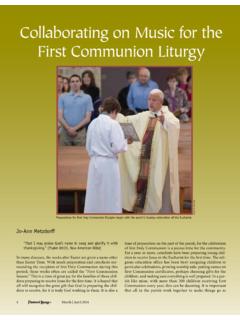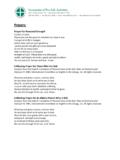Transcription of Walking in the Light of the Resurrection: The Corpus ...
1 Walking in the Light of the resurrection : The Corpus Christi what we do outside: we immerse [Christ], so to speak, in the daily routine of our lives, so that he may walk where we walk and live where we live. 5As we move from inside to outside, we must also move from an insider mentality to an awareness that Christ is for everyone. The procession represents an immense and public blessing for our city. 6 To process is to go forward, and thus the procession speaks of the possibility of change, of transformation in Christ, for ourselves, our Church, our world: with the gift of himself in the Eucharist the Lord Jesus sets us free from our paralyses, he helps us up and enables us to proceed, that is, he makes us take a step ahead and then another step. 7 The Eucharistic procession helps us recognize who we are as a Catholic community, and points us toward solidarity with others: Those who recognize Jesus in the sacred Host, recognize him in their suffering brother or sister.
2 8 Walking with Jesus in this procession, we can see ourselves as members of his Body, but we can also look at the world through the loving eyes of Jesus the ProcessionThe liturgical books offer surprisingly little guidance on how the procession should be carried out. The Roman Missal speaks of the importance of the procession, but offers few details: It is desirable that a procession take place after the Mass in which the Host to be carried in the procession is consecrated.. If a pro-cession takes place after Mass, when the Communion of the faithful is over, the monstrance in which the consecrated host has been placed is set on the altar. When the Prayer after Communion has been said, the Concluding Rites are omitted and the proces-sion forms. This is useful information, of course, but a few things are missing: how to organize the procession, where to go, and what to do when you get there! As Adolf Adam observes, Rome does not regard the Corpus Christi procession as a litur-gical act falling under Roman law and its sole supervision, but as Corinna LaughlinWhile the origins of many of our feasts and solemnities have been obscured, or even lost, in the passing of many centuries, Corpus Christi is different.
3 The origins of this feast can be traced to the year 1209, when St. Juliana of Li ge, a nun in a quiet Augustinian convent in France, had a vision of a full moon, with one dark spot. The full moon represented the Church s liturgical year; the dark spot, a missing feast honoring the sacrament of Christ s about the same time, there was a groundswell of Eucharistic devotion all over Europe, including the first recorded instance of the priest elevating the consecrated host during the Mass, which happened in Paris in 1220. It took time, but Church leaders listened to Juliana: in 1246, the Bishop of Li ge intro-duced a local feast in honor of the Blessed Sacrament, and in 1261, a former archdeacon of Li ge became Pope Urban IV and brought St. Juliana s vision to the universal Church. He enlisted the help of St. Thomas Aquinas, one of the greatest theologians of the Eucharist, who composed prayers and splendid hymns for the feast.
4 By the four-teenth century, the Eucharistic procession had become an important part of the observance of Corpus why a procession? What does it mean? In recent years, Pope Benedict XVI has spoken eloquently about the meaning of the procession for contemporary Catholics in his homilies for the feast. The procession is a profession of faith: the Solemnity of Corpus Christi developed at a time when Catholics were both affirming and defining their faith in Jesus Christ, alive and truly present in the Most Holy Sacrament of the Eucharist, 1 and the procession is a public statement of that belief. But there is more. Benedict s statements emphasize the link with another Eucharistic procession that of the Holy Thursday Evening Mass of the Lord s Supper, when the Blessed Sacrament is borne from the main altar to the altar of repose. On Corpus Christi, the church relives the mystery of Holy Thursday in the Light of the resurrection . 2 No longer Walking with Jesus to the garden of Gethsemane, now we are following the risen Lord who goes ahead.
5 To Galilee (Matthew 28:7). Thus the procession with the Blessed Sacrament has an evangelizing movement, taking the Gospel to the world in obedience to Christ s great the same time, though, the procession is not just for Catholics: the mystery of the Eucharist is for everyone. The sac-rament of the Lord s Body and Blood always goes above and beyond the walls of our churches. 3 Christ gives himself for us, but not just for us. The procession is a tangible realization of this, for as we go beyond our church walls, we walk with the Risen One in his journey to meet the entire world. 4 The proces-sion blurs the separation between what we do inside the church, The Corpus Christi procession has an evangelizing movement, taking the Gospel to the world, in obedience to Christ s St. James Cathedral / Maria LaughlinA crossbearer leads the procession. At St. James Cathedral, Seattle, Washington, the thurifer and candleholders, who immediately precede the priest or celebrant carrying the Blessed Sacrament, are placed in the middle of the procession.
6 Photo St. James Cathedral / Maria LaughlinMay | June 20146their finery again), candidates for Confirmation (perhaps wear-ing red), neophytes baptized at the Easter Vigil or catechumens and candidates in the ongoing process of the Rite of Christian Initiation of Adults, social outreach volunteers, Catholic school children in uniform, Knights of Columbus, Catholic Daughters of America, catechists, liturgical ministers the list can go on. The procession is, of course, for the entire assembly, and should not be thought of as a series of special groups but inviting such groups to join in can foster participation in the procession. Space these groups throughout the procession, not all in one place. In this way, their presence can help to give shape to the does the procession go? How long should it be? Here again, the Ceremonial of Bishops offers some recommendations but no hard-and-fast guidelines: There may be stations where eucharistic benediction is given, if there is such a custom and some pastoral advantage recommends it.
7 It is fitting that the procession go from one church to another. But, when local circumstances require, the procession may return to the church where it began (392 393). The Ceremonial specifies only that At the end of the procession, eucharistic benediction is given in the church where the procession ends or in some other suitable place (CB, 394). The Corpus Christi procession is definitely not a one-size-fits-all devotion. Inner-city parishes may be able to walk to another nearby church or chapel. In more suburban set-tings, the route might make a loop, moving around the block or around several blocks, and ending back at the church or in an outdoor gathering area. If you have not done the procession before, keep it short and simple. The procession does not need to be miles long (or even many blocks) to be profoundly meaningful. Evaluate the route each year. Does it speak to the full meaning of this public statement of faith? Or does it play it safe, perhaps staying too close to home?
8 We might consider the words of Pope Francis: one of the pia exercitia (exercises of devotion) that come under the bishop s supervision. 9 Fortunately, the Ceremonial of Bishops (CB) fills in a few of the blanks. If the procession follows immediately upon the end of Mass, the celebrant can wear the chasuble or a cope if a lengthy period of adoration has intervened, then the cope is the proper vesture (see 390). Following the Prayer after Communion, the celebrant adds incense to the thurible, then goes to the altar, kneels, and incenses the Blessed Sacrament. Then he receives the humeral veil and picks up the monstrance. The Ceremonial indicates the order for the procession the cross-bearer, accompanied by candlebearers, leads the way, but the thurifer does not walk in front of the cross as usual; rather, as on Holy Thursday, two thurifers come immediately before the bishop (or priest) carrying the Blessed Sacrament. A baldachin (canopy) may be carried over the priest if desired.
9 The Ceremonial also notes that all carry can- dles, and torchbearers escort the blessed sacra-ment (CB, 391).One significant element is missing from this description of the procession: the faithful! The Ceremonial simply states, the procession should be arranged in accordance with local custom in regard to the decoration of the streets and the order to be fol-lowed by the faithful who take part (392). Thus, there is room for in fact, need for a fair amount of creativity in arranging the procession. The makeup of your parish community, the loca-tion of your church, and even the layout of the sanctuary will all have an impact on how the procession happens in your commu-nity. One thing is certain the procession can happen in just about any community, large or small, urban or dva nce Pr ePa r at ionsBegin with catechesis. Even if you have done the procession for years perhaps especially if you have always done it provide some background on the origin and meaning of the solemnity in the bulletin or in homilies in the weeks preceding the Corpus Christi celebration.
10 We cannot reiterate too many times what the procession is about, because, as the passages quoted above from Pope Benedict s homilies reflect, it has many dimensions. It is about faith in the Real Presence; it is about service of others; it is about who we are as Catholics; it is about Christ meeting the whole world. Provide clear communication on practical matters as well. Tell people in advance when the procession will occur, where it will go, and (for some the most important detail of all) how long it will take. Help people to know that their presence and participation parish councils and ministries to participate as groups. In the Middle Ages, the various guilds from ship-wrights and bookbinders to butchers, bakers, and candlestick makers all took part, often wearing their distinctive garb. Our society is obviously quite different, but we can echo this aspect of the procession by thinking about the groups in the parish who could be encouraged to participate together: for instance, the children who have made their first Holy Communion (wearing Multiple music groups, including children s choirs, spaced throughout the procession help to carry the St.)













